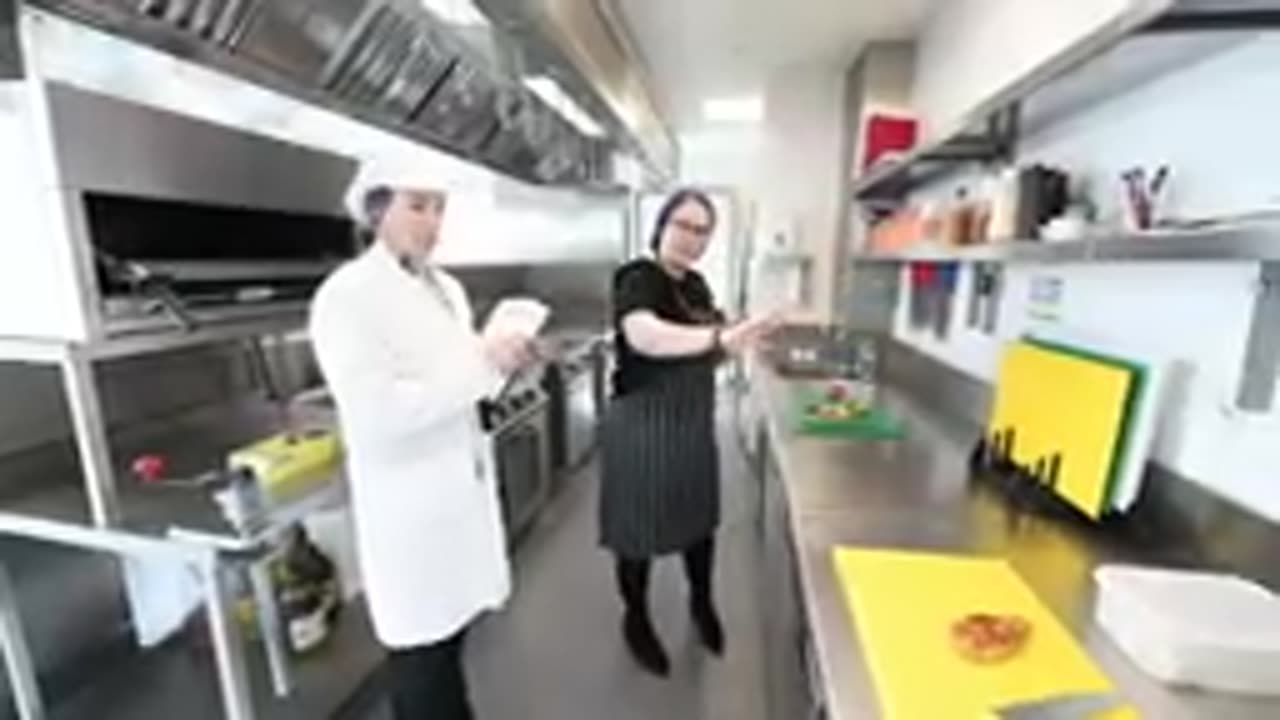Premium Only Content

Food safety - food hygiene inspections
Food safety and food hygiene inspections are critical processes designed to ensure that food establishments, such as restaurants, cafes, catering services, and food production facilities, meet established standards for hygiene, sanitation, and safe food handling. These inspections are conducted by local health authorities and are meant to protect consumers from foodborne illnesses and other health risks.
Here’s an overview of **food safety and food hygiene inspections**, the standards they assess, and the process involved:
---
### **Key Aspects of Food Safety and Hygiene Inspections**
1. **Food Storage and Temperature Control**
- **Cold Storage**: Inspectors check that refrigeration units (fridges and freezers) are maintained at the correct temperatures. Perishable foods must be stored at **41°F (5°C)** or below, and frozen foods should be stored at **0°F (-18°C)** or lower. This ensures that bacteria and pathogens do not grow on food.
- **Hot Holding**: Hot foods should be kept at **135°F (57°C)** or above. Inspectors will check whether foods are stored at the right temperature to prevent the growth of harmful bacteria.
2. **Food Handling and Cross-Contamination Prevention**
- **Separate Storage**: Raw meats, poultry, and seafood should be stored separately from ready-to-eat foods, such as vegetables and fruits, to prevent cross-contamination. Inspectors will verify that these storage practices are being followed.
- **Clean Hands and Utensils**: Inspectors check that staff are washing their hands properly before handling food, particularly after handling raw food or using the restroom. Food should be handled with **utensils, gloves**, or **tongs** to minimize direct hand contact.
- **Use of Color-Coded Cutting Boards**: Different cutting boards should be used for raw meat and ready-to-eat foods to prevent cross-contamination.
3. **Employee Health and Hygiene**
- **Health Certification**: In many jurisdictions, employees must have **food safety certifications** to handle food. Inspectors check that employees are knowledgeable about food safety procedures.
- **Illness Reporting**: Employees who are sick (particularly those with symptoms like vomiting, diarrhea, or fever) should not be handling food. Inspectors will check whether there are systems in place for employees to report illness.
- **Proper Uniforms**: Employees must wear **clean uniforms** and **hair restraints**, such as hats or nets, to prevent contamination from hair or personal hygiene.
4. **Sanitation Practices**
- **Cleaning Procedures**: Inspectors evaluate how regularly and thoroughly food preparation areas are cleaned. Surfaces that come into contact with food must be cleaned and sanitized properly.
- **Dishwashing**: The establishment should have a functioning dishwashing system, usually a **three-compartment sink** for washing, rinsing, and sanitizing. If a commercial dishwasher is used, inspectors will check the sanitation cycle to ensure it’s operating at the correct temperature.
- **Waste Disposal**: Food waste and trash should be regularly removed and stored in **pest-proof containers**. Inspectors check that trash areas are clean and free of food debris that could attract pests.
5. **Pest Control**
- Inspectors look for signs of **pests** (insects, rodents, etc.) in food storage and preparation areas. They verify whether the establishment has **pest control measures** in place, such as traps, seals on windows and doors, or regular professional pest control services.
6. **Food Safety Documentation**
- **Temperature Logs**: Inspectors will check whether the business is maintaining logs for the temperatures of refrigerators, freezers, and hot-holding units. Regular temperature checks should be documented to ensure food safety.
- **Food Safety Plan**: Some establishments are required to maintain a **Food Safety Management Plan** (e.g., **HACCP** - Hazard Analysis and Critical Control Points) to ensure food safety throughout the production process.
7. **General Cleanliness**
- Inspectors will evaluate the overall cleanliness of the establishment, including the **kitchen**, **food prep areas**, **storage rooms**, **restrooms**, and **staff areas**.
- All areas should be free from food waste, spills, and dirt that could contribute to contamination.
---
### **Steps in the Food Safety and Hygiene Inspection Process**
1. **Pre-Inspection Review**
- Health inspectors may review the establishment’s inspection history, complaints, and previous inspection reports. They might also assess the establishment’s **food safety training records** and employee certifications.
2. **Initial Walkthrough**
- The inspector will typically begin with a **visual inspection** of the establishment, checking the overall layout, cleanliness, and whether food safety practices are being followed (e.g., hand washing, proper storage).
3. **Detailed Inspection**
- The inspector will thoroughly check food storage, preparation areas, equipment, and sanitation practices. They’ll ensure that food is stored at proper temperatures, cross-contamination risks are minimized, and cleaning protocols are followed.
- They may use a **temperature probe** to measure food temperatures and evaluate whether hot foods are being kept at safe temperatures.
4. **Interviews with Staff**
- Inspectors may ask employees about food safety protocols and **how they handle food**. They will assess the staff’s understanding of hygiene, temperature control, and other food safety measures.
5. **Documentation Review**
- Inspectors will ask to review temperature logs, cleaning schedules, and food safety plans to ensure the business is complying with regulations. They will verify that records are being properly kept.
6. **Identifying Violations**
- Inspectors will identify any violations based on local food safety regulations. Violations can be categorized as **critical** (which pose an immediate health risk) or **non-critical** (which are less urgent but still need attention).
7. **Issuing an Inspection Report**
- After completing the inspection, the inspector will provide a written report detailing **violations** (if any) and the actions required to address them. The report will include a **score** or grade (depending on local regulations) and may also outline **follow-up inspection** dates or deadlines for corrections.
- **Critical Violations**: If critical violations are found (such as improper food temperatures or contamination risks), the inspector may require immediate correction, and the establishment may be temporarily closed until violations are fixed.
- **Non-Critical Violations**: Non-critical violations may be given a timeline for correction, with follow-up inspections to verify compliance.
---
### **Food Safety and Hygiene Inspection Scores and Public Disclosure**
- Many health departments, including those in areas like **Maricopa County**, use a **score or grade system** to rate the cleanliness and food safety practices of an establishment.
- In some areas, inspection results are publicly posted or available online for consumers to view. This transparency helps customers make informed decisions about where to dine.
---
### **Consequences of Failed Inspections**
- **Fines**: Violations can result in fines if not corrected within the required timeframe.
- **Closure Orders**: In extreme cases of **critical violations** (e.g., severe contamination, pest infestations, or inadequate food safety practices), inspectors may issue a temporary closure order until issues are resolved.
- **Re-inspection**: The establishment may be required to undergo a **follow-up inspection** to ensure that violations have been corrected.
---
### **Conclusion**
Food safety and hygiene inspections are an essential part of maintaining public health standards in food establishments. These inspections ensure that food is prepared, stored, and served safely, protecting consumers from foodborne illnesses and other health risks. For food service businesses, it's vital to maintain high hygiene and food safety standards consistently to avoid violations, maintain good inspection scores, and ensure the safety of their customers.
Would you like more information on specific inspection criteria, how to prepare for an inspection, or the consequences of non-compliance?
-
 1:45:47
1:45:47
The Quartering
6 hours agoHuge Censorship Law To Pass, Trump Endorses Johnson, TikTok is Saved? & Today's News!
85.9K59 -
 53:39
53:39
PMG
3 days ago $1.25 earned"Allegations Against Diddy & Usher, $150K Bounty on Trump, RINO Speaker Caves w/Steve Baker"
6.34K -
 1:31:21
1:31:21
Tucker Carlson
5 hours agoBrigham Buhler: UnitedHealthcare CEO Assassination, & the Mass Monetization of Chronic Illness
178K216 -
 2:29:04
2:29:04
Nerdrotic
6 hours ago $11.35 earnedHappy New Years - Nerdrotic Nooner 454
76.6K13 -
 32:20
32:20
Rethinking the Dollar
5 hours agoThe U.S. Debt Crisis That Was "Made In America" w/ Paul Stone
55K10 -
 3:31
3:31
SLS - Street League Skateboarding
1 day agoCoco Yoshizawa’s 3rd Place Finish at SLS Tokyo 2024 | Best Tricks
59.1K5 -
 46:15
46:15
Grant Stinchfield
1 day ago $13.68 earnedNew: The COVID Cover-up Revealed! Team Biden Caught in a Big Lie!
53.8K18 -
 2:35:08
2:35:08
The Shannon Joy Show
20 hours ago🔥🔥LIVE Exclusive W/Daniel Horowitz - New Year 2025 Analysis On Culture, Economy & Politics🔥🔥
59.6K17 -
 33:14
33:14
Tudor Dixon
6 hours agoThe World Walk with Tom Turcich | The Tudor Dixon Podcast
40.3K2 -
 7:29:48
7:29:48
PudgeTV
11 hours ago🔴 Gaming on Rumble - Marvel Rivals | Iron Man's Armory: Equipping Groot and Jeff for Battle
43.5K3